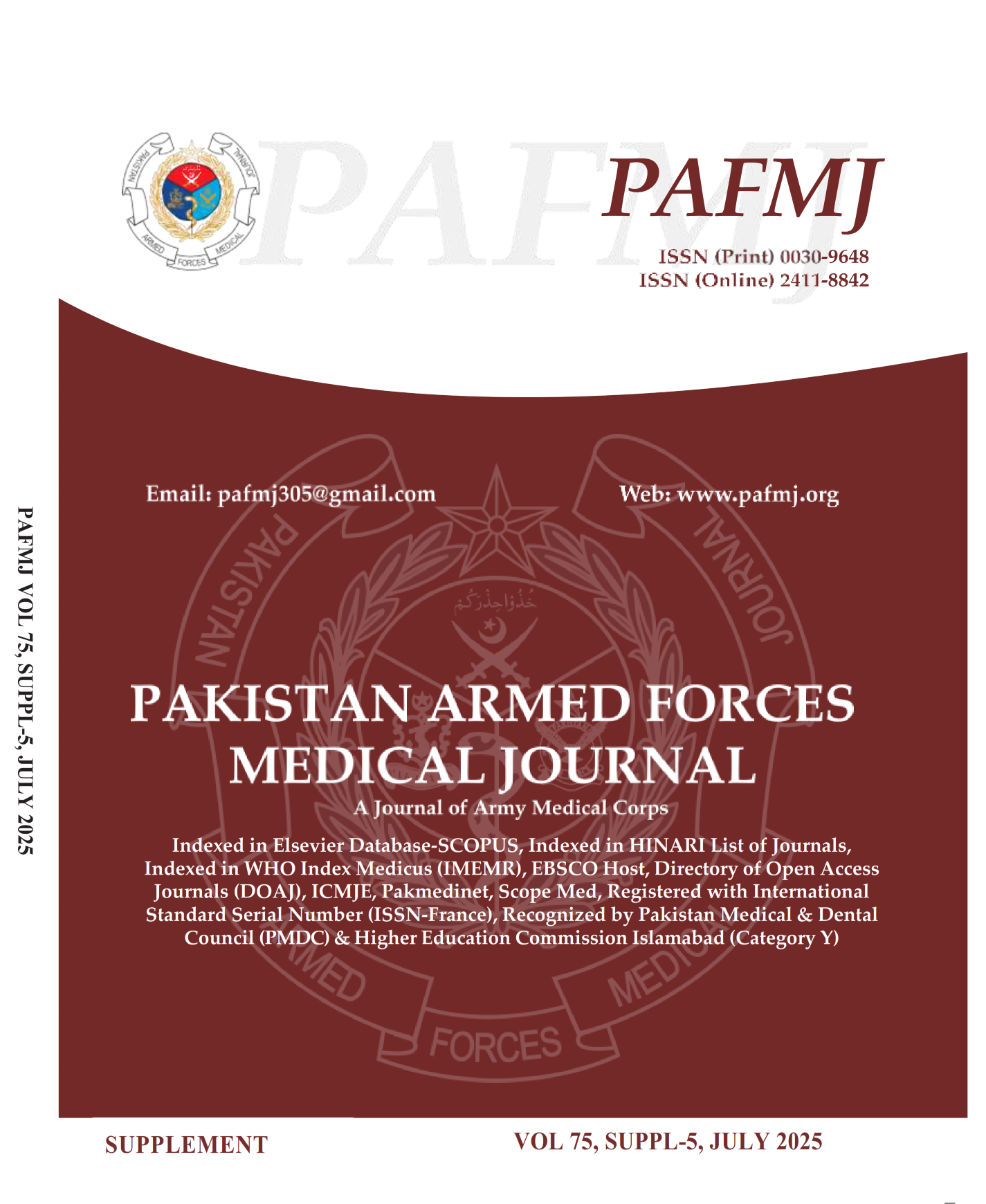Comparison of Perinatal Outcome for All Modes of Second Stage Delivery in Obstetrics Theatres
DOI:
https://doi.org/10.51253/pafmj.v75iSUPPL-5.8414Keywords:
Forceps delivery; Labor; Neonates; OutcomeAbstract
Objective: To compare the perinatal outcome for all modes of second stage delivery in obstetrics theatre of Pak Emirates Military Hospital
Study Design: Comparative Cross-sectional Study.
Place and Duration of Study: Pak Emirates Military Hospital Rawalpindi, Pakistan from Jun 2021 to Jan 2022.
Methodology: Neonates born at second stage of delivery in obstetric theatre via any assisted mode were recruited for this study. Neonatal outcome parameters were observed in babies delivered via instrumental delivery (forceps or vacuum) and delivery via caesarian section. These parameters (shoulder dystocia, neonatal intensive care unit admission, neonatal injury and 5-min APGAR<7) were compared in all the groups to look for any statistically significant difference.
Results: A total of 150 neonates fulfilling criteria set for the study were included in the final analysis. Mean age of the women included in the study was 33.343±6.431 years. 42(28%) were managed via forceps, 23(15.3%) were managed via vacuum and 85(56.7%) via emergency caesarian section. Statistical analysis revealed that shoulder dystocia and neonatal injury were found statistically significantly less in neonates born to women who were managed via forceps delivery (p-value<0.05).
Conclusion: Caesarian was the commonest mode of delivery used in women who were managed for prolonged second stage of labor. Considerable number of babies born to these mothers had various complications. Use of forceps delivery method emerged as a relatively safer method in our study participants.
Downloads
References
1. Al-Wassia H, Saber M. Admission of term infants to the neonatal intensive care unit in a Saudi tertiary teaching hospital: cumulative incidence and risk factors. Ann Saudi Med. 2017; 37(6): 420‐424. https://doi:10.5144/0256-4947.2017.420
2. Quddusi AI, Razzaq A, Hussain S, Hussain A. Pattern of neonatal admission at the Children's Hospital and the Institute of Child Health, Multan. J Ayub Med Coll Abbottabad. 2012; 24(2): 108‐110
3. Chow S, Chow R, Popovic M, et al. A Selected Review of the Mortality Rates of Neonatal Intensive Care Units. Front Public Health. 2015; 3(2): 225. Published 2015 Oct 7. https://doi:10.3389/fpubh.2015.00225
4. Fisher AL, Sangkhae V, Presicce P, Chougnet CA, Jobe AH, Kallapur SG, et al. Fetal and amniotic fluid iron homeostasis in healthy and complicated murine, macaque, and human pregnancy. JCI Insight. 2020 Feb 27;5(4):e135321.
https://doi: 10.1172/jci.insight.135321.
5. Salman M, Rathore H, Arif S, Ali R, Khan AA, Nasir M. Frequency of Immediate Neonatal Complications (Hypoglycemia and Neonatal Jaundice) in Late Preterm and Term Neonates. Cureus. 2021 Jan 5;13(1):e12512.
https://doi: 10.7759/cureus.12512.
6. Khowaja WH, Leghari AL, Hussain AS, Ariff S, Khan IA. Frequency and Early Complications of Late Preterm Infants: A Descriptive Analysis from Two Secondary-care Hospitals of Karachi. Cureus. 2019 Sep 28;11(9):e5789.
https://doi: 10.7759/cureus.5789.
7. Eze P, Lawani LO, Chikezie RU, Ukaegbe CI, Iyoke CA. Perinatal outcomes of babies delivered by second-stage Caesarean section versus vacuum extraction in a resource-poor setting, Nigeria - a retrospective analysis. BMC Pregnancy Childbirth. 2020 May 14;20(1):298.
https://doi: 10.1186/s12884-020-02995-9.
8. Shmueli A, Salman L, Ashwal E, Hiersch L, Gabbay-Benziv R, Yogev Y, Aviram A. Perinatal outcomes of vacuum assisted versus cesarean deliveries for prolonged second stage of delivery at term. J Matern Fetal Neonatal Med. 2017 Apr;30(8):886-889. https://doi: 10.1080/14767058.2016.1191066.
9. Benedetto C, Marozio L, Prandi G, Roccia A, Blefari S, Fabris C. Short-term maternal and neonatal outcomes by mode of delivery. A case-controlled study. Eur J Obstet Gynecol Reprod Biol. 2007 Nov;135(1):35-40.
https://doi: 10.1016/j.ejogrb.2006.10.024.
10. Tufail A, Qayyum A, Naheed F, Ahsan NA, Jehan M. The Impact of Mode of Delivery On Maternal and Perinatal Outcome In Vertex / Breech Presentation In The Leading Twin. J Surg Pak. 2020:25(2): 77-82.
11. Kvalvik LG, Wilcox AJ, Skjærven R, Østbye T, Harmon QE. Term complications and subsequent risk of preterm birth: registry based study. BMJ. 2020;369:m1007. Published 2020 Apr 29. https://doi:10.1136/bmj.m1007
12. Matta P, Turner J, Flatley C, Kumar S. Prolonged second stage of labour increases maternal morbidity but not neonatal morbidity. Aust N Z J Obstet Gynaecol. 2019 Aug;59(4):555-560. https://doi: 10.1111/ajo.12935.
13. Tenaw Z, Kassa ZY, Kassahun G, Ayenew A. Maternal Preference, Mode of Delivery and Associated Factors among Women Who Gave Birth at Public and Private Hospitals in Hawassa City, Southern Ethiopia. Ann Glob Health. 2019;85(1):115. Published 2019 Aug 19.
https://doi:10.5334/aogh.2578
14. Karataşlı V, Kanmaz AG, İnan AH, Budak A, Beyan E. Maternal and neonatal outcomes of adolescent pregnancy. J Gynecol Obstet Hum Reprod. 2019 May;48(5):347-350.
https://doi: 10.1016/j.jogoh.2019.02.011.
15. Salman L, Aviram A, Krispin E, Wiznitzer A, Chen R, Gabbay-Benziv R. Adverse neonatal and maternal outcome following vacuum-assisted vaginal delivery: does indication matter? Arch Gynecol Obstet. 2017 May;295(5):1145-1150.
https://doi: 10.1007/s00404-017-4339-3.
16. Nolens B, van den Akker T, Lule J, Twinomuhangi S, van Roosmalen J, Byamugisha J. Women's recommendations: vacuum extraction or caesarean section for prolonged second stage of labour, a prospective cohort study in Uganda. Trop Med Int Health. 2019 May;24(5):553-562. https://doi: 10.1111/tmi.13222.
17. Tan PS, Tan JKH, Tan EL, Tan LK. Comparison of Caesarean sections and instrumental deliveries at full cervical dilatation: a retrospective review. Singapore Med J. 2019 Feb;60(2):75-79. https://doi: 10.11622/smedj.2018040.
18. Polkowski M, Kuehnle E, Schippert C, Kundu S, Hillemanns P, Staboulidou I. Neonatal and Maternal Short-Term Outcome Parameters in Instrument-Assisted Vaginal Delivery Compared to Second Stage Cesarean Section in Labour: A Retrospective 11-Year Analysis. Gynecol Obstet Invest. 2018; 83(1): 90-98. https://doi: 10.1159/000458524
Downloads
Published
Issue
Section
License
Copyright (c) 2025 Mehwish Adnan, Abeera Choudry, Sadaf Mumtaz, Sobia Hanif, Uroosa Din muhammad

This work is licensed under a Creative Commons Attribution-NonCommercial 4.0 International License.















